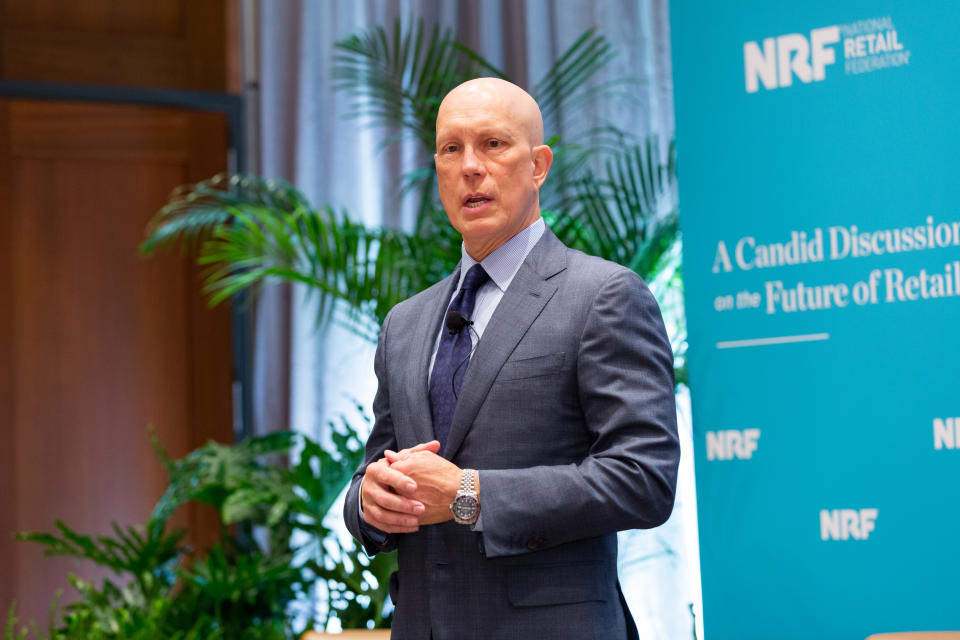NRF Sees Retailers Rocking for Holiday Despite Headwinds

It’s going to be a record-breaking holiday season for retail sales despite supply chain bottlenecks, inventory and labor shortages, inflation and COVID-19.
That’s according to the National Retail Federation which on Wednesday predicted 2021 holiday sales will grow between 8.5 and 10.5 percent from 2020 to between $843.4 billion and $859 billion.
More from WWD
The projected numbers surpass the previous record of 8.2 percent in 2020 to $777.3 billion and the average increase of 4.4 percent over the past five years, the NRF indicated in its annual holiday forecast.
The retail trade organization expects online and other nonstore sales, which are included in the total, will increase between 11 and 15 percent to a total of between $218.3 billion and $226.2 billion driven by online purchases. That compares to $196.7 billion in 2020.
The NRF holiday forecast is for the Nov. 1 to Dec. 21 period and excludes automobile dealers, gas and restaurants.
“There is considerable momentum heading into the holiday shopping season,” said NRF president and chief executive officer Matthew Shay. “Consumers are in a very favorable position going into the last few months of the year as income is rising and household balance sheets have never been stronger. Retailers are making significant investments in their supply chains and spending heavily to ensure they have products on their shelves to meet this time of exceptional consumer demand.”

Jenna Bascom Photography
“The unusual and beneficial position we find ourselves in is that households have increased spending vigorously throughout most of 2021 and remain with plenty of holiday purchasing power,” added NRF chief economist Jack Kleinhenz.
“Pandemic-related supply chain disruptions have caused shortages of merchandise and most of this year’s inflationary pressure,” Kleinhenz said. “With the prospect of consumers seeking to shop early, inventories may be pulled down sooner and shortages may develop in the later weeks of the shopping season. However, if retailers can keep merchandise on the shelves and merchandise arrives before Christmas, it could be a stellar holiday sales season.”
As reported, Customer Growth Partners expects U.S. retail sales to be up 6.7 percent for the November to December holiday shopping season, which the research and consulting firm said represents a sharp slowdown from the 14 percent growth seen year-to-date through September. Mastercard predicts holiday retail sales growing 7.4 percent.
While it appears new COVID-19 infections and hospitalizations are down, the NRF acknowledged that a variant surge could potentially sidetrack the trajectory of spending. But Kleinhenz said strong household fundamentals provide optimism amid the uncertainty. Income is growing from wage compensation, and household wealth has reached another record high, supporting strong holiday 2021 spending.
As reported by WWD, retailers have been encouraging consumers to shop earlier for gifts, and launched holiday campaigns weeks earlier than last year in many cases, due to potential product shortages and to alleviate shopping surges that tax their ability to properly serve consumers and deliver goods on time for Christmas. NRF expects retailers will hire between 500,000 and 665,000 seasonal workers, compared with 486,000 in 2020. Retailers have been aggressive in staging job fairs and providing incentives to fill tens of thousands of vacancies at stores, call and distribution facilities.
NRF’s holiday forecast is based on economic modeling that considers employment, wages, consumer confidence, disposable income, consumer credit, previous retail sales and weather.
During a press conference, Shay said: “There may be some shortages requiring consumers to switch some buying. Their first choice may not available, but we think the assortments will be there at the right price and consumers won’t be deterred from shopping. They will shop. They will purchase. They will find an item. They won’t go home empty-handed. Retailers have brought in plenty of inventory but are still seeing some delays.
“It’s our view that the pandemic didn’t so much create these problems in our supply chain, but made more visible the lack of investment in the infrastructure, the real solution to this is a long-term one, it’s going to require investment,” which is why the NRF is so supportive of President Joe Biden’s infrastructure bill.
Shay noted that retail sales have grown year-over-year every month since May 2020 when “we really began to emerge from initial lockdowns. That momentum has continued. For the first nine months of this year, retail sales have increased by 14.5 percent. Across the board heading into holiday season, what we see is very strong momentum.”
Shay is convinced that if shoppers don’t find their first choice for a gift, they will select another item to buy. “Early in the pandemic, when there was some stockouts, like cleaning supplies, and people were working from home, a substantial number of consumers tried brands for the first time and many retailers engaged with new customers. Consumers are comfortable trying new brands and shopping in new ways. Consumer behavior has changed in many ways, and there is a willingness to pay more [at] full price.”
Asked if small, independent retailers can weather the headwinds as well as larger competitors, Shay replied: “It is true they don’t have the same resources. For smaller retailers in urban areas, the challenge has been the lack of return of workers to offices.” But Shay said smaller retailers can operate successfully and compete, by offering unique products and services, “meeting customers in ways other retailers cannot.”
Sign up for WWD's Newsletter. For the latest news, follow us on Twitter, Facebook, and Instagram.

